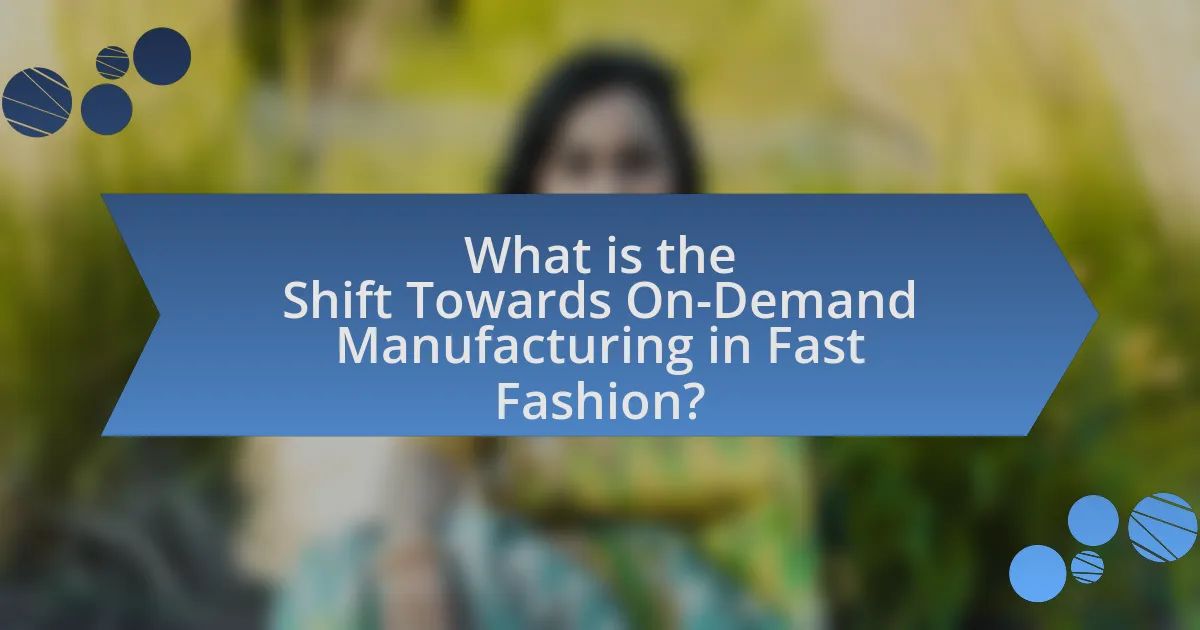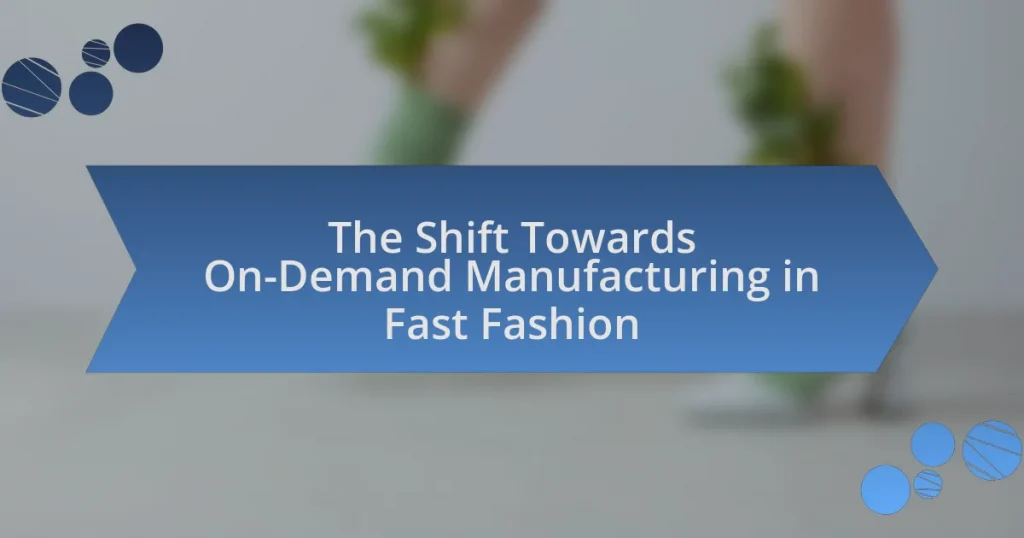The article focuses on the shift towards on-demand manufacturing in the fast fashion industry, highlighting its transition from traditional mass production to a model that produces clothing only after an order is placed. This approach aims to reduce excess inventory and waste, aligning with sustainability goals while enhancing responsiveness to consumer trends. Key characteristics of on-demand manufacturing include customization, advanced technology integration, and improved inventory management. The article also discusses the challenges and benefits of this model, including cost savings, increased customer satisfaction, and the influence of consumer demand and sustainability concerns on its adoption. Additionally, it examines how brands are adapting to this model and the future implications for the fast fashion industry.

What is the Shift Towards On-Demand Manufacturing in Fast Fashion?
The shift towards on-demand manufacturing in fast fashion refers to the transition from traditional mass production to a model where clothing is produced only after an order is placed. This approach reduces excess inventory and waste, aligning with sustainability goals. According to a report by McKinsey & Company, on-demand manufacturing can decrease lead times and improve responsiveness to consumer trends, allowing brands to adapt quickly to market demands. This model is increasingly adopted by companies aiming to enhance efficiency and reduce environmental impact in the fashion industry.
How does on-demand manufacturing differ from traditional fast fashion production?
On-demand manufacturing differs from traditional fast fashion production primarily in its approach to inventory and production timing. On-demand manufacturing produces items only after an order is placed, minimizing excess inventory and waste, while traditional fast fashion relies on mass production of large quantities in advance, leading to overstock and unsold goods. This model of on-demand production aligns with sustainability goals, as it reduces the environmental impact associated with unsold inventory and textile waste, which is a significant issue in the fast fashion industry, where an estimated 92 million tons of textile waste are generated annually.
What are the key characteristics of on-demand manufacturing?
On-demand manufacturing is characterized by its ability to produce goods only when there is a confirmed order, minimizing waste and inventory costs. This model allows for greater customization, as products can be tailored to specific customer preferences, enhancing consumer satisfaction. Additionally, on-demand manufacturing leverages advanced technologies such as 3D printing and digital fabrication, which enable rapid prototyping and production. This approach also supports sustainability by reducing overproduction and excess inventory, aligning with the growing demand for environmentally responsible practices in the fast fashion industry.
How does on-demand manufacturing impact inventory management?
On-demand manufacturing significantly reduces the need for large inventory levels in fast fashion. By producing items only as they are ordered, companies can minimize excess stock and associated holding costs. This approach leads to a more agile inventory management system, allowing businesses to respond quickly to changing consumer preferences and trends. For instance, a study by McKinsey & Company highlights that brands utilizing on-demand manufacturing can decrease inventory waste by up to 30%, demonstrating the effectiveness of this model in optimizing inventory management.
Why is the shift towards on-demand manufacturing occurring now?
The shift towards on-demand manufacturing is occurring now due to advancements in technology, changing consumer preferences, and the need for sustainability in the fast fashion industry. Technologies such as 3D printing and digital design enable rapid production and customization, allowing brands to respond quickly to market trends. Additionally, consumers increasingly demand personalized products and are more conscious of environmental impacts, prompting brands to reduce waste associated with traditional mass production. According to a report by McKinsey & Company, the fast fashion sector is projected to grow by 20% annually, highlighting the urgency for brands to adopt on-demand strategies to remain competitive and meet evolving consumer expectations.
What role does consumer demand play in this shift?
Consumer demand drives the shift towards on-demand manufacturing in fast fashion by prioritizing customization and rapid response to trends. As consumers increasingly seek unique, personalized products and expect quick delivery times, brands are compelled to adapt their production processes to meet these expectations. For instance, a report by McKinsey & Company highlights that 66% of consumers are willing to pay more for personalized products, indicating a strong market incentive for brands to implement on-demand manufacturing strategies. This shift not only enhances customer satisfaction but also reduces waste and overproduction, aligning with sustainability goals in the fashion industry.
How do sustainability concerns influence on-demand manufacturing?
Sustainability concerns significantly influence on-demand manufacturing by driving the adoption of practices that minimize waste and resource consumption. On-demand manufacturing allows companies to produce items only as needed, reducing overproduction and excess inventory, which are major contributors to environmental degradation in the fast fashion industry. For instance, a study by the Ellen MacArthur Foundation highlights that the fashion industry generates 92 million tons of waste annually, and on-demand models can mitigate this by aligning production with actual consumer demand. This shift not only addresses ecological impacts but also enhances brand reputation among environmentally conscious consumers, further promoting sustainable practices in manufacturing.
What challenges does the shift towards on-demand manufacturing present?
The shift towards on-demand manufacturing presents challenges such as increased production costs, supply chain complexities, and the need for advanced technology integration. Increased production costs arise because on-demand manufacturing often requires smaller batch sizes, which can lead to higher per-unit costs compared to traditional mass production. Supply chain complexities emerge as manufacturers must adapt to fluctuating consumer demands and manage inventory more dynamically, which can strain existing logistics systems. Additionally, the need for advanced technology integration, including automation and data analytics, poses a challenge for companies that may lack the necessary infrastructure or expertise to implement these systems effectively.
What technological advancements are necessary for successful implementation?
Successful implementation of on-demand manufacturing in fast fashion requires advancements in automation, data analytics, and supply chain integration. Automation technologies, such as robotics and AI-driven production systems, enhance efficiency and reduce lead times, enabling rapid response to consumer demand. Data analytics tools facilitate real-time insights into consumer preferences and inventory levels, allowing for more accurate forecasting and production planning. Additionally, seamless supply chain integration through advanced software platforms ensures that all stakeholders, from suppliers to retailers, can collaborate effectively, minimizing delays and optimizing resource allocation. These advancements collectively support a more agile and responsive manufacturing process, essential for meeting the dynamic needs of the fast fashion industry.
How do supply chain dynamics change with on-demand manufacturing?
Supply chain dynamics shift significantly with on-demand manufacturing by reducing lead times and inventory costs. On-demand manufacturing allows companies to produce goods only when there is a confirmed order, which minimizes excess inventory and associated holding costs. This model enhances responsiveness to market trends, as production can be adjusted quickly based on real-time demand data. According to a study by McKinsey & Company, companies that adopt on-demand manufacturing can reduce their inventory levels by up to 30%, leading to improved cash flow and reduced waste. Additionally, this approach fosters closer collaboration between suppliers and manufacturers, as they must communicate effectively to meet fluctuating consumer demands.

How is on-demand manufacturing transforming the fast fashion industry?
On-demand manufacturing is transforming the fast fashion industry by enabling brands to produce clothing in response to actual consumer demand rather than relying on bulk production. This shift reduces overproduction and waste, addressing significant sustainability concerns within the industry. For instance, a study by McKinsey & Company highlights that on-demand manufacturing can decrease inventory costs by up to 30% and minimize unsold stock, which often leads to landfill waste. Additionally, this model allows for greater customization and faster turnaround times, aligning production with current trends and consumer preferences, thus enhancing customer satisfaction and engagement.
What benefits does on-demand manufacturing offer to fast fashion brands?
On-demand manufacturing offers fast fashion brands significant benefits, including reduced inventory costs and increased responsiveness to market trends. By producing items only when there is a confirmed demand, brands minimize the risk of overproduction and excess stock, which can lead to financial losses. This model allows for a more agile supply chain, enabling brands to quickly adapt to changing consumer preferences and trends, thereby enhancing their competitive edge. Additionally, on-demand manufacturing can lead to more sustainable practices by reducing waste associated with unsold inventory, aligning with the growing consumer demand for environmentally responsible fashion.
How does it enhance customer satisfaction and engagement?
On-demand manufacturing enhances customer satisfaction and engagement by providing personalized products that meet individual preferences and reducing lead times. This approach allows brands to respond quickly to market trends and customer feedback, ensuring that offerings are relevant and desirable. According to a study by McKinsey & Company, 70% of consumers are more likely to purchase from brands that offer personalized experiences, demonstrating the direct correlation between customization and customer loyalty. Additionally, on-demand manufacturing minimizes excess inventory, leading to more sustainable practices, which resonates with environmentally conscious consumers, further boosting engagement.
What cost savings can brands expect from on-demand manufacturing?
Brands can expect significant cost savings from on-demand manufacturing, primarily through reduced inventory costs and minimized waste. By producing items only as they are ordered, brands eliminate the need for large inventories, which can lead to excess stock and markdowns. According to a study by McKinsey & Company, on-demand manufacturing can reduce inventory holding costs by up to 30%, as brands only produce what is needed based on real-time demand. Additionally, this model decreases the risk of unsold products, which can account for up to 25% of total production costs in traditional manufacturing. Thus, on-demand manufacturing not only streamlines production but also enhances financial efficiency for brands in the fast fashion sector.
How are brands adapting to the on-demand manufacturing model?
Brands are adapting to the on-demand manufacturing model by implementing flexible production processes and leveraging technology for real-time inventory management. This shift allows brands to reduce waste and respond quickly to consumer demand, as evidenced by companies like Zara, which utilizes data analytics to forecast trends and adjust production accordingly. Additionally, brands are increasingly adopting digital platforms that facilitate direct-to-consumer sales, enabling them to produce items only after receiving orders, thereby minimizing excess inventory and associated costs.
What strategies are successful brands employing?
Successful brands in fast fashion are employing on-demand manufacturing strategies to enhance efficiency and reduce waste. This approach allows brands to produce clothing items only after receiving customer orders, minimizing excess inventory and aligning production with actual consumer demand. For instance, companies like Zara and H&M have adopted agile supply chain practices that enable rapid response to market trends, resulting in reduced lead times and improved customer satisfaction. Research indicates that on-demand manufacturing can decrease production costs by up to 30% while also contributing to sustainability efforts by lowering material waste.
How do collaborations with technology providers facilitate this shift?
Collaborations with technology providers facilitate the shift towards on-demand manufacturing in fast fashion by enabling the integration of advanced technologies such as artificial intelligence, automation, and data analytics. These technologies streamline production processes, reduce lead times, and enhance supply chain efficiency. For instance, companies like Zara have partnered with tech firms to implement real-time inventory management systems, allowing for quicker response to consumer demand and minimizing overproduction. This collaboration not only optimizes resource allocation but also supports sustainable practices by reducing waste, as evidenced by a report from McKinsey & Company, which highlights that on-demand manufacturing can decrease excess inventory by up to 30%.

What are the future implications of on-demand manufacturing in fast fashion?
On-demand manufacturing in fast fashion will likely lead to reduced waste and increased sustainability in the industry. This approach allows brands to produce clothing only when there is a confirmed order, minimizing overproduction, which is a significant issue in traditional fast fashion that contributes to environmental degradation. According to a 2021 report by McKinsey & Company, the fashion industry generates over 92 million tons of waste annually, highlighting the urgent need for more sustainable practices. By adopting on-demand manufacturing, companies can respond more flexibly to consumer demand, thus aligning production with actual sales and reducing excess inventory. Additionally, this model can enhance customization options for consumers, allowing for personalized products that cater to individual preferences, further driving consumer engagement and loyalty.
How might consumer behavior evolve with on-demand manufacturing?
Consumer behavior may evolve towards increased personalization and reduced impulse buying with on-demand manufacturing. As consumers gain access to customized products tailored to their preferences, they are likely to prioritize quality and uniqueness over mass-produced items. This shift is supported by a 2021 study from McKinsey & Company, which found that 71% of consumers expressed a desire for personalized products, indicating a growing trend towards individualized shopping experiences. Additionally, the immediacy of on-demand manufacturing may lead consumers to make more deliberate purchasing decisions, as they can order items that meet their specific needs rather than succumbing to the allure of fast fashion’s rapid turnover.
What trends are emerging in consumer preferences?
Emerging trends in consumer preferences indicate a significant shift towards sustainability, personalization, and convenience. Consumers increasingly prioritize eco-friendly products, with a 2022 survey revealing that 66% of global consumers are willing to pay more for sustainable brands. Additionally, there is a growing demand for personalized shopping experiences, as 80% of consumers are more likely to make a purchase when brands offer personalized experiences. Convenience remains a key factor, with the rise of on-demand manufacturing allowing consumers to receive products faster and tailored to their specific needs. These trends reflect a broader movement towards responsible consumption and enhanced customer engagement in the fast fashion industry.
How could on-demand manufacturing influence fashion cycles?
On-demand manufacturing could significantly shorten fashion cycles by enabling brands to produce items based on real-time consumer demand rather than forecasts. This shift allows for quicker response times to trends, reducing the lag between design and availability. For instance, brands like Zara have already adopted rapid production techniques, resulting in new collections being introduced every few weeks instead of traditional seasonal releases. This approach minimizes overproduction and waste, as items are only created when there is confirmed interest, aligning production closely with consumer preferences. Consequently, on-demand manufacturing can lead to a more agile fashion industry that adapts swiftly to changing trends and consumer behaviors.
What best practices should brands follow when implementing on-demand manufacturing?
Brands should prioritize flexibility and responsiveness when implementing on-demand manufacturing. This involves utilizing advanced technologies such as AI and data analytics to forecast demand accurately, enabling brands to produce only what is needed, thus minimizing waste. Additionally, establishing strong relationships with suppliers and manufacturers is crucial for ensuring quick turnaround times and maintaining quality standards.
Research indicates that companies employing on-demand manufacturing can reduce inventory costs by up to 30% while increasing customer satisfaction through personalized products. Furthermore, integrating sustainable practices, such as using eco-friendly materials and processes, aligns with consumer preferences and enhances brand reputation. These best practices collectively support a more efficient, sustainable, and customer-centric approach in the fast fashion industry.
How can brands ensure quality control in on-demand production?
Brands can ensure quality control in on-demand production by implementing rigorous quality assurance processes throughout the manufacturing cycle. This includes establishing clear quality standards, conducting regular inspections at various production stages, and utilizing technology such as automated quality checks and data analytics to monitor product consistency. For instance, a study by McKinsey & Company highlights that brands employing real-time data tracking can reduce defects by up to 30%, demonstrating the effectiveness of these methods in maintaining high-quality outputs in fast fashion’s on-demand manufacturing landscape.
What role does data analytics play in optimizing on-demand manufacturing?
Data analytics plays a crucial role in optimizing on-demand manufacturing by enabling real-time decision-making and enhancing operational efficiency. By analyzing consumer data, manufacturers can accurately forecast demand, reducing excess inventory and minimizing waste. For instance, a study by McKinsey & Company found that companies utilizing data analytics in their supply chain processes can achieve up to a 20% reduction in operational costs. Furthermore, data analytics facilitates the customization of products based on consumer preferences, allowing manufacturers to respond swiftly to market trends and improve customer satisfaction. This data-driven approach not only streamlines production processes but also aligns manufacturing capabilities with actual market needs, thereby enhancing overall competitiveness in the fast fashion industry.















